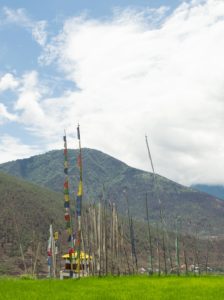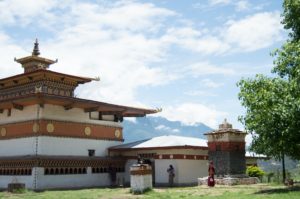By: David Watkins
Chimi Lhakhang, also known as the fertility temple, is one of the most famous and most well-regarded temples in Bhutan. Situated on a hill in the mountainous farmland of Bhutan, there is rich, mysterious history surrounding this beautiful temple. The founder, Drukpa Kunley, is a revered religious figure in Bhutan, but his character, however, is not of the purity that we often envision religious figures to have. The tales of Drukpa Kunley and his escapades throughout Bhutan are often laden with sexual innuendos, profanity, and his ‘Flaming Thunderbolt of Wisdom’. He conveys his Buddhist teachings through comedic presentations and crude humor which separates him from his more modest Buddhist peers. These tales have made him into a cultural hero and even more beloved by the Bhutanese. The story of Drukpa Kunley’s foundation of Chimi Lhakhang is no exception to these references which makes the temple well-loved by Bhutanese and foreigners alike.

Chimi Lhakhang

Rice paddy near Chimi Lhakhang
Mythical Founding of Chimi Lhakhang
The story of the founding of Chimi Lhakhang begins with Drukpa Kunley’s entrance into Bhutan when, around the 15th century, the Bhutanese were tortured or killed by demons and demonesses of the land. Drukpa Kunley, also known as the Divine Madman, entered Bhutan on a mission to tame these demons and demonesses. Most stories claim that Kunley used his penis, aptly named “The Flaming Thunderbolt of Wisdom”, to tame or kill these demons. It is during his quest to slay the demons and demonesses of Bhutan that Chimi Lhakhang, the fertility temple, is established.
On his mission to slay the demons of Bhutan, Drukpa Kunley entered a land he named Lokthang Kyamo which means ‘Arid Land’. Here, Drukpa Kunley encountered a man named Apa who was preparing for the end of his life. To get ready for his death, the old man requested a teaching. Drukpa Kunley fulfilled his request and instructed Apa to recite the prayer whenever he thought of him. The prayer, however, was an extremely vulgar and explicit saying. When Apa recited the saying in front of his daughter and wife, they thought him to be mad, eventually insisting that he stay in a separate room because of the vulgarity of the prayer. After some time, Apa’s daughter went to check on him and discovered that he had vanished and presumably died. Drukpa Kunley returned to the spot where the old man had died and constructed a stupa. Chimi Lhakhang would later be built around this stupa.
Considering that many of the tales of Drukpa Kunley are spread by word of mouth, the consistency of these stories often vary greatly. The story of Chimi Lhakhang is no exception. An alternate story of the founding of the temple involves Drukpa Kunley taming a demoness which takes the form of a dog with his Thunderbolt of Wisdom. He then builds a stupa on top of the dog and Chimi Lhakhang (“No Dog Temple”) is built around the stupa.

Prayer flags on the way to Chimi Lhakhang
Historical Development
While not there is not much information on the history of the physical construction, we do know that it was built in 1499 by Ngawang Chogyel who was the 14th Drukpa hierarch. Some records claim that Ngawang Chogyel was the brother of Drukpa Kunley while others state that he is simply an abbot. Since its inception the temple has been used as a vehicle to incite fertility in the women of Bhutan and foreigners alike. Today, countless women who have had issues conceiving or women who hope to become mothers in the future still visit Chimi Lhakhang in hopes of being blessed with fertility. After making an offering, they receive a blessing from a monk in the temple who taps them on the head with what is supposedly Drukpa Kunley’s phallus. Women also frequent this temple to receive names for their newborn children.
In what may come as a surprise to some, the temple’s powers have been proven by a myriad of women who claim that the temple and blessing has cured them of their infertility. Often, women who visit the temple consequently bear children. The women send in photos of them with their children to the temple which the monks keep in an album as testament to the temple’s powers. Though we did not receive the blessing of fertility, to see this strange yet delightful temple in person was an unforgettable experience. As a foreigner naïve to the myths of Bhutan and Buddhism, this temple was a wonderful introduction to one of Bhutan’s greatest and most coveted legends.

Farmers working in a rice paddy near Chimi Lhakhang

Monk pointing near the stupa
Bibliography:
Chimi Lhakhang. (n.d.). Retrieved August 10, 2018, from https://www.lonelyplanet.com/bhutan/attractions/chimi-lhakhang/a/poi-sig/1537759/1335521
Chimi Lhakhang | The Fertility Temple | andBeyond. (n.d.). Retrieved August 5, 2018, from https://www.andbeyond.com/experiences/asia/bhutan/punakha/chimi-lhakhang-fertility-temple/
Chimi Lhakhang – The Fertility Temple Bhutan in Punakha District. (2018, January 02). Retrieved August 10, 2018, from https://bhutantravel.guide/chimi-lhakhang-fertility-temple-bhutan-punakha-district/
Dge-ʼdun-rin-chen, B. D., Dowman, K., & Paljor, S. (2014). The divine madman: The sublime life and songs of Drukpa Kunley. Middletown, DE.: Dzogchen Now! Books.
Monson, E. (2014). Drukpa Kunle. Retrieved August 10, 2018, from https://treasuryoflives.org/biographies/view/Drukpa-Kunle/TBRC_P816
Monson, E. L. (2015). Ethical Formation in the Works and Life ‘Brug Smyon Kun Dga’ Legs Pa. Retrieved August 8, 2018.
Why This Bhutanese Monastery Is Covered in Phallic Imagery. (2015, October 22). Retrieved August 5, 2018, from https://www.atlasobscura.com/places/chimi-lhakhang